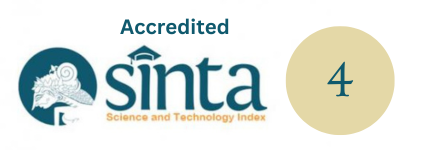Wisala Meru Musical Artwork | Karya Musik Wisala Meru
DOI:
https://doi.org/10.59997/jurnalsenikarawitan.v1i3.394Kata Kunci:
interprestasi, Meru, Semar Pegulingan, seni.Abstrak
Karya Seni Musik Wisala Meru merupakan karya komposisi kreasi baru yang dikemas dengan tetap bernuansa tradisi. Judul Wisala Meru memiliki arti yaitu bangunan suci atau meru yang terkenal akan keagungan, ketinggian, dan kemegahannya. Karya ini adalah interprestasi dari pelinggih Meru yang mempunyai tumpang berlapis-lapis semakin mengecil keatas hingga menjulang tinggi menyerupai bentuk gunung. Karya ini terinspirasi dari konsep Tri Angga (kepala, badan, dan kaki) pada Meru yang selanjutnya menjadi konsep dalam gubahan musik Wisala Meru ini. Karya Wisala Meru menggunakan gamelan Semar Pegulingan sebagai media ungkap dan penambahan instrumen kempur dengan kendang gupekan dan cedetan. Penggarapan unsur musikal dalam garapan karawitan ini difokuskan kepada penggarapan ritme, melodi, tempo, warna suara, dinamika, serta penjiwaan pada setiap materi. Proses penciptaan karya ini dilakukan dengan lima tahapan yang terinspirasi dari metode I Wayan Dibia dalam buku Metodologi Penciptaan Seni yakni: Tahap Inspirasi (Ngawirasa), Eksplorasi (Ngewacak), Konsepsi (Ngerencana), Tahap Eksekusi (Ngawangun) dan yang terakhir Tahap Ngebah (Maedeng). Karya ini diwujudkan dalam bentuk tabuh kreasi yang masih berpijak pada ranah tradisi, pembaharuan yang terdapat dalam karya ini terletak pada formulasi musik yang menggunakan tumbukan patet-patet yang dimiliki oleh gambelan Semar Pegulingan untuk merealisasikan replika bangunan suci Meru. Sehingga karya seni musik Wisala Meru merupakan suatu iterprestasi dari bentuk bangunan Meru dengan Semar Pegulingan sebagai media ungkap menjadi suatu karya seni musik yang megah.
Unduhan
Referensi
A.A.M.Djelantik (1999) Estetika: Sebuah Pengantar. Bandung: Masyarakat Seni Pertunjukan Indonesia (MSPI).
Angreni, D. (2016) Pelinggih Meru. Denpasar: Lontar Bali.
Aryasa, I. W. M. D. (1985) Pengetahuan Karawitan Bali. Denpasar: Departemen Pendidikan dan Kebudayaan Bali.
Bayu, G. et al. (2017) ‘Kajian Konsep , Estetik dan Makna pada Ilustrasi Rangda Karya Monez’, Prabangkara, 21(2), pp. 68–79.
Dasar, D. I. and Meru, B. (2016) ‘Makna Filosofis Keberadaan Ornamen Bedawang Nala Di Dasar Bangunan Meru’, Jurnal Filsafat, 20(1), pp. 45–55. doi: 10.22146/jf.3432.
Diatmika, I. W. I. et al. (2015) ‘Pengembangan Aplikasi Instrumen Gamelan Semar Pegulingan Berbasis Android’, 4.
Dibia, I. W. (2020) Panca Sthiti Ngawi Sani Metodologi Penciptaan Seni. Denpasar: Pusat Penerbitan LPPMPP Institut Seni Indonesia Denpasar.
Eriawati, Y. (2018) ‘Pola Tata Ruang Bangunan, Rumah-Rumah dan Fungsi di Desa Adat Pengotan Kabupaten Bangli’, Jurnal Penelitian Arkeologi Papua dan Papua Barat, 9(1), pp. 85–107.
Gede Risa Sutra Gita, I. K. S. (2021) ‘Introduction to the Musical Composition “Tirtha Nadi” | Pengantar Karya Komposisi Karawitan “Tirtha Nadi”’, GHURNITA: Jurnal Seni Karawitan, 01(02), pp. 75–83. doi: 10.25124/ghurnita.v1i1.151.
Hendra Santosa (2020) ‘Critical Analysis On Historiography Of Gamelan Bebonangan In Bali’, Paramita: Historical Studies Journal, 30(1), pp. 98–107. doi: 10.15294/paramita.v30i1.18480.
Putra, I. K. A., Santosa, H. and Sudirga, I. K. (2020) ‘The Concept of Balance at Sekati Ririg Gending in Tejakula , Buleleng Regency’, HARMONIA jurnal Arts Of Research and Education, 20(2), pp. 183–194. doi: 10.15294/harmonia.v20i2.25412.
Putu Paristha Prakasih, Hendra Santosa, I. G. Y. (2018) ‘Tirtha Campuhan: Karya Komposisi Baru dengan Media Gamelan Semar Pagulingan’, Resital: Jurnal Seni Pertunjukan. Institut Seni Indonesia Yogyakarta, 19(3), pp. 113–121. doi: 10.24821/resital.v19i3.2452.
Santosa, H. (2005) Pengetahuan Multimedia Jilid 1. Denpasar.
Santosa, H. S. (2016) ‘Gamelan Sistem Sepuluh Nada dalam Satu Gembyang untuk Olah Kreativitas Karawitan Bali’, Pantun, 1(2), pp. 85–96. Available at: https://jurnal.isbi.ac.id/index.php/pantun/article/view/747.
Suastika, I Gede Putu. Sudiana, I Nyoman. Sudhana, I. K. (2020) ‘Manis Batu Sebuah Garapan Kreasi Baru Gamelan Semar Pagulingan Saih Pitu’, Segara Widya, 8(1), pp. 1–12. Available at: https://jurnal.isi-dps.ac.id/index.php/segarawidya/article/view/1046.
Sugiartha, I. G. A. (2012) Kreativitas Musik Bali Garapan Baru Perspektif Cultural Studies. Denpasar: Institut Seni Indonesia Denpasar.
Suprianta, I. M., Yudarta, I. G. and Pasek, I. N. (2019) Meru pitu. Institut Seni Indonesia Denpasar.
William, R. et al. (2017) ‘THE ARCHITECTURE OF PAGODAS VIEWED FROM THE ANGLE OF SITE LAY-OUT , PROPORTION , AND’, 01(April).








